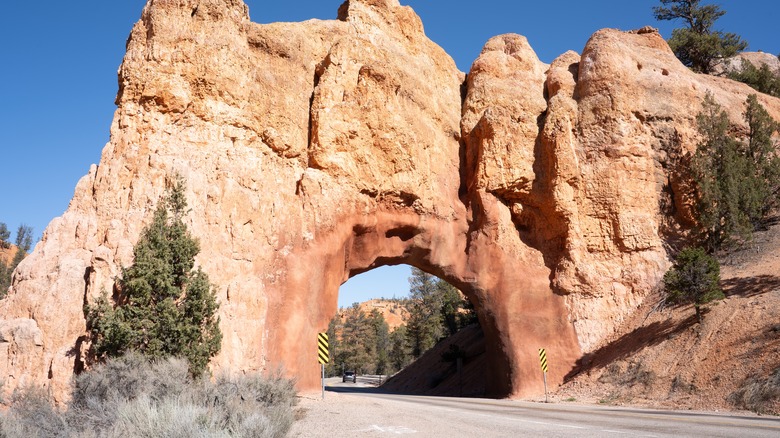A Massive National Forest In Utah Offers Picture-Perfect Views, Recreation, And Foliage
Utah is well known for its stunning and adventurous national parks, such as Zion National Park with its steep mountainous cliffs and incredible vistas or Bryce Canyon National Park with its spectacular gorges that rival those of the Grand Canyon. However, few visitors realize that Utah has even more majestic beauty and wild, rugged terrain to offer in its national forests — and none are quite a match for the massive and magnificent Dixie National Forest.
Dixie National Forest lies snug between Capitol Reef National Park and the Grand Staircase-Escalante National Monument, spanning a whopping 2 million acres bordered on either side by protected public lands. The lowlands of this enormous forest start at around 2,800 feet in elevation and rise as high as 11,322 feet at Boulder Mountain. This area offers endless opportunities for recreation, such as canoeing and boating in the various lakes, camping in any of the more than 20 designated campgrounds, or exploring the archaeological history of cliff dwellings adorned with incredible petroglyphs from times past.
The forest features a diverse array of landscapes and wilderness zones, making it a perfect destination for those seeking the red-rocked beauty of places like Zion, speckled with contrasting foliage of dark green pines and firs. Or perhaps you seek the quiet, untrammeled evergreen forests of protected wilderness areas, for which Dixie National Forest has several, where you can truly experience nature as it was intended to be — untouched, unaltered by man, pristine, and perfect. In Dixie National Forest, there are so many wonders to discover around every bend, where surely there is something for everyone.
Exploring the many features of Dixie National Forest
Thanks to the Forest Reserve Act of 1891, the Wilderness Act of 1964, and more, there are still areas in the United States that are entirely protected, left to remain as the wild and untamed lands that they have been for all of time. Dixie National Forest is home to three major plateaus (Markagunt, Paunsaugunt, and Aquarius) and four distinct protected wilderness areas to explore. Features of these wilderness areas even rival those of some of the fantastic sights and wonders of Utah's Mighty 5 national parks, all in one place.
In Pine Valley, you can climb to the soaring heights of Signal Peak, with 10,356 feet of elevation, where you'll find picture-perfect views of the surrounding parks (so long as the weather is clear). Box-Death Hollow is the place to go if you are searching for those iconic pale-orange sandstone canyons of the likes of Canyonlands National Park (with fewer crowds). Hike through the miles of trails within the Ashdown Gorge wilderness and experience the old-growth Bristlecone forests. Or you can even explore where the plateaus, gorges, and magnificent cliffs of Zion continue outside the park into the most recently incorporated wilderness area of Dixie, Cottonwood Forest.
For those seeking the unique and fascinating red sandstone formations that you can find in nearby Bryce Canyon, look no further than Red Canyon in Dixie National Forest. Here you can enjoy scenic hiking, biking, and off-roading among the towering cliffs lined with lush swaths of sweet-smelling pine and juniper. Want to escape the heat? You can check out the underground wonders of Mammoth Cave, one of Utah's largest lava tubes. It's easily accessible and a fun, family-friendly adventure that will be unforgettable!
Recreation and stays in Utah's Dixie National Forest
In addition to all the hiking and exploring you can do in Dixie National Forest, there are also many dazzling and tremendous lakes scattered throughout, which are great for recreation. You can experience epic swimming in Panguitch Lake, situated over 8,000 feet high above the hills, where the sky is vast and the sunshine is abundant. There is also Enterprise Reservoir, a pinyon-lined lake that is popular for recreation such as kayaking, boating, and fishing. It also offers close access to off-highway vehicle (OHV) areas for those seeking thrills on their adventures, such as the Pinnacles OHV trail and the Hardscrabble OHV trail. Another notable lake in the Dixie National Forest is Navajo Lake, a natural reservoir perfect for wildlife viewing, where you may spot creatures such as mule deer, elk, and even the infamous cougar scouring the rocky crags for its dinner.
You will have no shortage of places to camp in Dixie National Forest, with 22 Forest Service-designated campgrounds. Some are more primitive, with only tent-camping spots available and little to no amenities, such as the Lava Flat Dispersed Camping Area. Others are more developed and include bathrooms, potable water, fire pits, and a dump station like the Panguitch Lake North Campground. If camping isn't exactly your style, there are other accommodation options available as well, including cabins that offer beds, a small kitchen, and even a wood-burning stove.
Of course, you can stay in any of the surrounding national parks/monuments and still venture out into the Dixie National Forest. Capitol Reef's only designated campground, Fruita Campground, is one option. You can also stay in one of the cozy log cabins available inside Grand Staircase-Escalante National Monument. However you choose to stay, visiting Dixie National Forest is an absolute must-do if you're planning a trip to see any of the amazing wonders found within the beautiful state of Utah. This massive forest has something for everyone and will not disappoint!


